Margaret Home, Countess of Moray (died 1683) was a Scottish aristocrat and compiler of recipe books.
Contents

Margaret Home, Countess of Moray (died 1683) was a Scottish aristocrat and compiler of recipe books.

She was the eldest daughter of Alexander Home, 1st Earl of Home (died 1619) and Mary Sutton, Countess of Home (died 1644).
Her siblings were her brother, James Home, 2nd Earl of Home (d. 1633) who married firstly, Catherine Cary (1609–1626) eldest daughter of Viscount Falkland and the playwright Elizabeth Tanfield Cary author of The Tragedy of Mariam , [1] and in 1626 married secondly Grace Fane (d. 1633) daughter of Francis Fane, 1st Earl of Westmorland and Mary Mildmay, and her younger sister, Anne Home, Countess of Lauderdale (d. 1671), who married John Maitland, 1st Duke of Lauderdale. Their daughter Mary Maitland married John Hay, 2nd Marquess of Tweeddale.
A Scottish author Patrick Hannay (fl. 1616–1630) dedicated A happy husband or, Directions for a Maide to choose her Mate, As also, a Wives behaviour towards her Husband after Marriage (Edinburgh, 1618/1619?) to Margaret Home. [2]
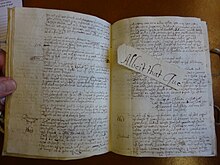
In October 1627 she married James Stuart, eldest son of the Earl of Moray, then known as "Lord Doune". [3] She had a nursery for her children in her mother's house in the Canongate of Edinburgh, now known as Moray House. After her brother, the Earl of Home died in 1633, she received a share of the composition of the barony of Home. She and her husband refurbished their house at Donibristle, employing English artisans including the painters, Edward Arthur [4] and George Crawford, and installed a fountain with a bronze figure of Mercury balanced on a tortoise. [5]
At Donibristle House, her cabinet included an early and luxurious telescope, bought in London in 1634 for £15 sterling. [6] Books included volumes of sermons and a work penned by Esther Inglis, [7] while Markham's Husbandry and Country Farm, a French book of plants and physic, and Parkinson's Herbal, may have been of practical use. She compiled three recipe books with the help of a clerk, including family recipes for medicines and culinary recipes supplied by a Mistress Young. A treatment diary written by her sister-in-law Grace Fane in 1628 was included, copied in Margaret Home's handwriting. [8]

In May 1650, the house in Canongate was used for the wedding party of her daughter Mary Stuart and Lord Lorne. It is said that the family and Archibald Johnston watched the captive Earl of Montrose being taken up the Royal Mile. Their encounter was depicted in 1859 by the history painter James Drummond. [9]
In 1652, Margaret Home made over lands in Moray from her dowry or terce to her husband, so that he could sell them to meet their debts. [10] He died in 1653. The Countess lived as a widow till 1683, she maintained Moray House in Edinburgh and its gardens, and planted woods at Donibristle. The writer Thomas Kirk saw the Mercury fountain in 1677. [11] After her death, her factor, the lawyer Hugh Paterson, working with one of her grandsons to make inventories, found a fortune in silver plate hidden in a cupboard at the Canongate. Hugh Paterson was the builder of Bannockburn House near Stirling. [12]
Their children included: [13]
Archibald Campbell, 5th Earl of Argyll was a Scottish nobleman, peer, and politician. He was one of the leading figures in the politics of Scotland during the reign of Mary, Queen of Scots, and the early part of that of James VI.
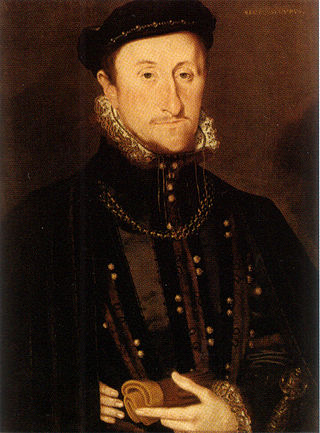
James Stewart, 1st Earl of Moray was a member of the House of Stewart as the illegitimate son of King James V of Scotland. At times a supporter of his half-sister Mary, Queen of Scots, he was the regent of Scotland for his half-nephew, the infant King James VI, from 1567 until his assassination in 1570. He was the first head of government to be assassinated with a firearm.

The title Earl of Moray, Mormaer of Moray or King of Moray was originally held by the rulers of the Province of Moray, which existed from the 10th century with varying degrees of independence from the Kingdom of Alba to the south. Until 1130 the status of Moray's rulers was ambiguous and they were described in some sources as "mormaers", in others as "Kings of Moray", and in others as "Kings of Alba". The position was suppressed by David I of Scotland some time after his defeat of Óengus of Moray at the Battle of Stracathro in 1130, but was recreated as a feudal earldom by Robert the Bruce and granted to Thomas Randolph, 1st Earl of Moray in 1312.
William Douglas, 6th Earl of Morton was the son of Robert Douglas of Lochleven and Margaret Erskine, a former mistress of James V of Scotland.
James Stewart, 2nd Lord Doune, 2nd Earl of Moray was a Scottish nobleman, the son of James Stewart, 1st Lord Doune and Margaret Campbell. He was murdered by George Gordon, Earl of Huntly as the culmination of a vendetta. Known as the Bonnie Earl for his good looks, he became the subject of a popular ballad, "The Bonnie Earl of Moray".
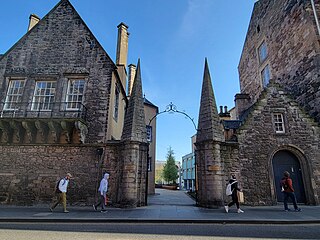
The Moray House School of Education and Sport is a school within the College of Arts, Humanities and Social Science at the University of Edinburgh. It is based in historic buildings on the Holyrood Campus, located between the Canongate and Holyrood Road.
Janet Kennedy, was a Scottish noble and the mistress of King James IV of Scotland.

James Stuart, 4th Earl of Moray was a Scottish landowner.
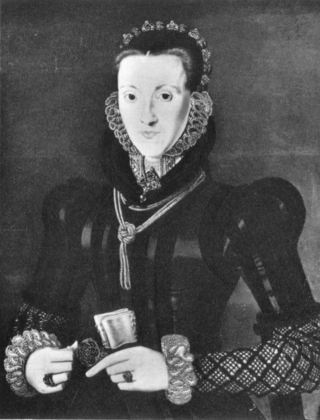
Agnes Keith, Countess of Moray was a Scottish noblewoman. She was the wife of James Stewart, 1st Earl of Moray, regent of Scotland and the illegitimate half-brother of Mary, Queen of Scots, making her a sister-in-law of the Scottish queen. As the wife of the regent, Agnes was the most powerful woman in Scotland from 1567 until her husband's assassination in 1570.

Donibristle was a house and estate in Fife, Scotland, on the coast of the Firth of Forth. Only the wings of the house remain, within the modern settlement of Dalgety Bay. They are now protected as a category A listed building. Donibristle was the scene of the killing of James Stewart, 2nd Earl of Moray, in 1592, which is remembered in the ballad "The Bonnie Earl O' Moray".

Mary Fane, Countess of Westmorland continued her mother Grace Mildmay's interest in physic and was a significant author of spiritual guidance and writer of letters.

James Home, 2nd Earl of Home was a Scottish nobleman.
Mary (Dudley) Sutton, Countess of Home (1586–1644), was a landowner, living in England and Scotland.
Mary Campbell, Countess of Argyll, formerly Lady Mary Stuart, was the wife of Archibald Campbell, 9th Earl of Argyll.
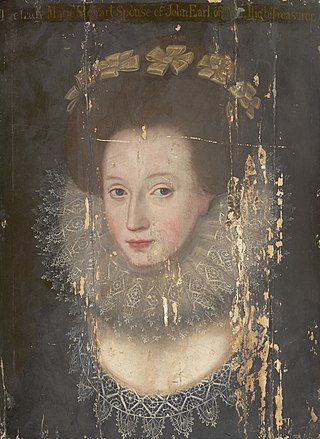
Marie Stewart, Countess of Mar (1576-1644) was a Scottish courtier. She was the daughter of Esmé Stewart, 1st Duke of Lennox and Catherine de Balsac d’Entragues (d. c.1631) and a favourite of James VI of Scotland. After her marriage, as was customary in Scotland, she did not change her name, and signed her letters as "Marie Stewart".
Simon Fraser, 6th Lord Lovat (1570–1633) was a Scottish courtier and landowner.
James Stewart, 1st Lord Doune (1529-1590) was a Scottish landowner.

Anne Home, Countess of Lauderdale (1612–1671) was a Scottish aristocrat.
Archibald Stewart was a Scottish merchant and Provost of Edinburgh.

Catherine or Katherine Tollemache, Countess of Sutherland was an English aristocrat.